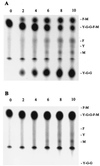Streptococcus parasanguis pepO encodes an endopeptidase with structure and activity similar to those of enzymes that modulate peptide receptor signaling in eukaryotic cells
- PMID: 10496897
- PMCID: PMC96872
- DOI: 10.1128/IAI.67.10.5206-5214.1999
Streptococcus parasanguis pepO encodes an endopeptidase with structure and activity similar to those of enzymes that modulate peptide receptor signaling in eukaryotic cells
Abstract
Studies in our laboratory have identified two fimbria-associated adhesins, FimA and Fap1, of Streptococcus parasanguis FW213. In this study, we isolated and sequenced DNA fragments linked to fimA to determine if they contained additional factors associated with adherence, virulence, or survival in the host. An open reading frame just upstream and divergently transcribed from the fimA operon was identified and named pepO. Northern hybridization indicated that pepO is transcribed as a monocistronic message. pepO encodes a predicted 631-amino-acid protein with a molecular mass of approximately 70.6 kDa. PepO contains the essential motif HEXXH, typical of many zinc-dependent metalloproteases and metallopeptidases. PepO has significant sequence identity to mammalian metallopeptidases, including endothelin-converting enzyme, which converts a potent vasoconstrictor into its active form, and neutral endopeptidase (NEP), which is involved in terminating the activity of opioid peptides. The opioid peptide metenkephalin is a natural substrate of NEP. Cell extracts of FW213 cleaved metenkephalin at the same site as does NEP, while an extract from an insertionally inactivated pepO mutant did not. These results indicate that FW213 pepO encodes an enzyme with activity similar to that of known mammalian endopeptidases. Phylogenetic analysis of PepO and its homologues suggests lateral genetic exchange between bacteria and eukaryotes.
Figures






References
-
- Altschul S F, Gish W, Miller W, Myers E W, Lipman J D. Basic local alignment search tool. J Mol Biol. 1990;215:403–410. - PubMed
-
- Andersson S G E, Zomorodipour A, Andersson J O, Sicheritz-Ponten T, Alsmark U C M, Podowski R M, Naslund A K, Eriksson A-S, Winkler H H, Kurland C G. The genome sequence of Rickettsia prowazekii and the origin of mitochondria. Nature. 1998;396:133–140. - PubMed
-
- Ausubel F M, Brent R, Kingston R E, Moore D D, Smith J A, Seidman J G, Struhl K, editors. Current protocols in molecular biology. New York, N.Y: John Wiley & Sons, Inc.; 1989.
Publication types
MeSH terms
Substances
Grants and funding
LinkOut - more resources
Full Text Sources
Other Literature Sources

